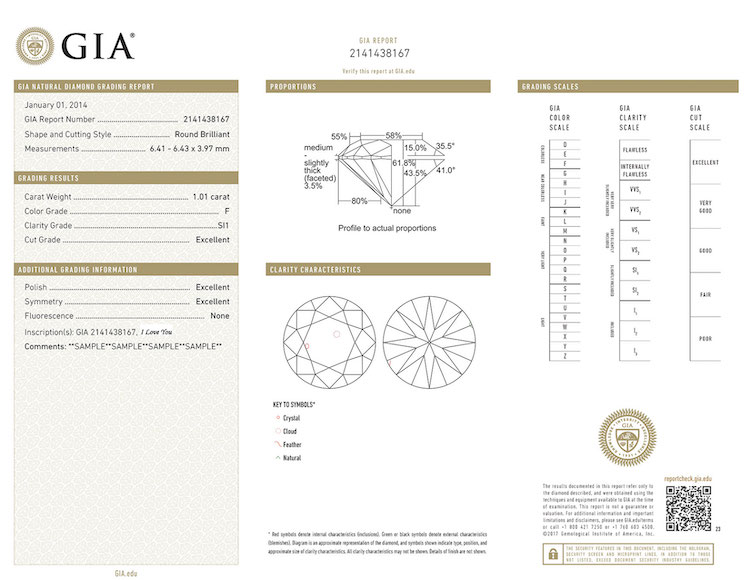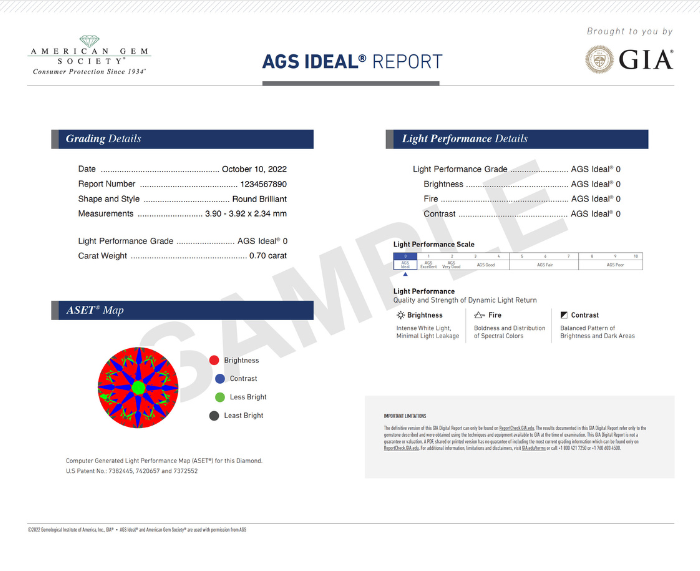Diamond Education
GIA Certification
In the dazzling world of diamonds, one can easily be overwhelmed by the myriad of choices available. This is where the importance of diamond certification comes into play. Certificates provide a reliable and consistent means of assessing a diamond's quality, providing buyers with the peace of mind they deserve when making such a significant purchase. Among the leading organizations providing diamond certification, the Gemological Institute of America (GIA) stands at the forefront. This article aims to guide you through the details of GIA Diamond Certification, elucidating its importance, process, and benefits.
Summary:
- What is the GIA?
- The GIA Diamond Grading Process
- How to Read a GIA Diamond Certificate
- Comparing GIA with AGS
- Comparing the GIA with Other Labs
- Conclusion
What is the GIA?
Founded in 1931, the Gemological Institute of America, or GIA, has been a beacon of integrity and standards in the gem industry for over 90 years. With a mission to protect all buyers and sellers of gemstones by setting and maintaining the standards used to evaluate gemstone quality, the GIA plays an essential role in the world of gems and jewelry.

The GIA developed the now globally accepted standard for describing diamonds: the 4Cs of Diamond Quality. This system, comprising Color, Clarity, Cut, and Carat Weight, has become the universal method for assessing the quality of any diamond, anywhere in the world. This revolutionary system transformed the gem industry and provided a standardized, unbiased way to evaluate and compare diamonds.
Whiteflash is renowned for its exceptional diamond quality and extensive collection of GIA-certified diamonds. If you're on the hunt for the perfect diamond, Whiteflash is a great place to start.
For those seeking a wider selection and flexible payment options, Blue Nile and James Allen are also excellent choices. These online diamond retailers offer an expansive range of GIA-certified diamonds to suit various styles and budgets. Shopping for diamonds has never been easier!
In the following sections, we will delve deeper into the GIA's diamond grading process, how to read a GIA diamond certificate, and the many benefits that come with a GIA certification. So, whether you're a first-time buyer or a diamond enthusiast, stick with us to uncover the fascinating world of GIA Diamond Certification.
The GIA Diamond Grading Process
When a diamond is sent to the GIA for grading, it undergoes a thorough evaluation by several highly trained gemologists who grade the stone based on the Institute's stringent standards. The cornerstone of GIA's grading process lies in the 4Cs of Diamond Quality.
Color is evaluated based on how little of it is present in the diamond, with the grading scale running from D (colorless) to Z (light yellow or brown). Clarity is assessed by the absence of inclusions and blemishes when viewed under 10x magnification. The Cut grade is determined by how well the diamond's facets interact with light, a critical factor that influences a diamond's brilliance. Lastly, the Carat Weight measures the diamond's size, with one carat equivalent to 200 milligrams.
Along with these four core characteristics, the GIA report also includes additional information such as the diamond's symmetry, fluorescence, and a unique plot mapping the diamond's inclusions.
How to Read a GIA Diamond Certificate
A GIA Diamond Certificate, also known as a Diamond Grading Report, is a comprehensive evaluation of your diamond that goes beyond the basic 4Cs. It offers a blueprint of your diamond's exact qualities and features.

On the report, you'll find the diamond's measurements, weight, depth, table, girdle thickness, culet size, and facet arrangement. It also includes grades for polish and symmetry and comments on any distinct features or additional identification characteristics. Importantly, the report includes a unique GIA report number which can be verified on GIA's online database.
Understanding these elements can help you make an informed decision when buying a diamond. It allows you to comprehend the exact characteristics of the diamond you are considering and how they affect its overall beauty and value.
Comparing GIA with AGS
In the world of diamond certification, the American Gem Society (AGS) is another notable player alongside GIA. The AGS has been known for its emphasis on cut grades, particularly for fancy shapes. This focus on cut has resulted in the AGS achieving significant recognition for its Ideal Cut Grade, a standard that has become synonymous with top-quality diamonds.
However, an important development has taken place that needs to be considered when comparing these two entities. GIA has acquired AGS, a move that is set to further the long-standing collaboration between the two in pursuit of their shared consumer protection missions. This acquisition will integrate AGS Laboratories' unique expertise, intellectual property, and technology to develop new GIA products and services to protect consumers and support the trade.

This strategic collaboration will help advance AGS's retailer programs and support more member education at the annual AGS Conclave and throughout the year. This advancement enables AGS to focus on its core mission and activities, enhancing benefits and services to deliver elevated value to its members and their customers as the industry evolves.
Ramifications of the Acquisition
The merger of AGS into GIA has some significant implications for the diamond industry and the services provided by these entities. The AGS Laboratories research staff, their intellectual property, and technology will be integrated into GIA, thus combining their research efforts. This is expected to result in innovative products and services that will improve how consumers and the trade understand and appreciate diamonds. This includes advancements in light performance research and the development of a science-based fancy cut grade standard.
In recognition of AGS Laboratories' significant contributions to the industry and consumer trust, the AGS Ideal® Report will continue to be available. However, it will now be a digital-only supplement to GIA diamond reports for eligible D-to-Z natural and laboratory-grown round brilliant and fancy shape diamonds. This supplemental report will have an additional cost of US$25, and GIA clients will be able to request these reports starting from January 2023.
Moving forward, AGS and GIA will work closely together to reimagine and extend their founders' vision, strengthen their collective effort to meet the complexities of a dynamic and changing industry, and ensure relevance for today's world and business environment while upholding their joint consumer protection missions and independence.
Comparing GIA with Other Diamond Labs
As we navigate the glittering world of diamonds, it's important to understand that while GIA is a leading authority in gemological research and diamond grading, it is not the only player in the field. There are numerous other laboratories worldwide that offer diamond grading services, each with its unique grading systems and scales.
However, GIA stands at the pinnacle of the diamond grading world. It is recognized globally as the most respected and trusted authority in gemology. GIA's rigorous standards, consistency in grading, and commitment to its mission of protecting both buyers and sellers of gemstones have earned it this esteemed position. When you purchase a GIA-certified diamond, you are assured that you're getting a gem that has been evaluated according to the highest global standards.
That being said, it's worth giving a nod to the International Gemological Institute (IGI). While GIA is known for its meticulous grading of natural diamonds, IGI has carved out a reputation for itself in the realm of lab-grown diamonds. IGI's grading reports for lab-grown diamonds are widely accepted within the industry, and the institute's commitment to providing detailed, accurate information about these diamonds has helped consumers make informed choices in this emerging market.
Other labs like the European Gemological Laboratory (EGL) and HRD Antwerp also offer diamond grading services, but their grading scales and standards might differ from those of GIA. It's essential to understand these differences when comparing diamonds certified by different labs. The EGL and HRD have been known to overgrade so beware!
In conclusion, while there are several reputable diamond grading laboratories worldwide, GIA continues to be the gold standard in the industry. Its reputation for integrity, accuracy, and consistency in diamond grading is unparalleled, making GIA-certified diamonds a preferred choice for consumers around the globe.
Conclusion
The journey of a diamond from a rough stone to a beautifully polished gem is complex and filled with intricacies. The work of the Gemological Institute of America (GIA) and the American Gem Society (AGS) plays a pivotal role in this journey, ensuring that the value, beauty, and integrity of each diamond are accurately represented.
In recent years, the diamond industry has experienced a significant shift with the acquisition of AGS by GIA. This merger combines the unique strengths of both organizations, paving the way for innovative products and services that benefit both the trade and consumers. The focus remains on maintaining transparency, fostering consumer trust, and enhancing the understanding and appreciation of diamonds.
With a GIA or AGS-certified diamond, you can be confident in the quality of your purchase. These certifications provide a comprehensive analysis of a diamond's characteristics, helping you make informed decisions. So, whether you're choosing a diamond for its brilliance, its size, or its rarity, remember that its true value lies in its quality, as certified by respected organizations like the GIA and AGS.
